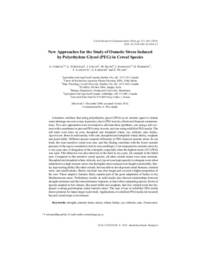New Approaches for the Study of Osmotic Stress Induced by Polyethylene Glycol (PEG) in Cereal Species

Authors:
Literature confirms that using polyethylene glycol (PEG) as an osmotic agent to imitate water shortage was not so easy in practice, due to PEG toxicity effects and frequent contaminations. Two new approaches were developed to alleviate those problems, one using a raft covered with a membrane to prevent PEG entry in roots, and one using solidified PEG media. The raft trials were done on corn, hexaploid and tetraploid wheat, rye, triticale, oats, barley, Agrotricum; those in solid media, with corn, hexaploid and tetraploid wheat, barley, sorghum and pearl millet. Different species respond differently to PEG-induced osmotic stress. In our trials, the most sensitive cereal was corn, and this finding correlates with the lower osmotic pressure of the sap (a constitutive trait in corn seedlings). Corn responded to osmotic stress by a very poor rate of elongation of the coleoptile, especially when the highest stress (32% PEG) was used. This behavior was also observed in the field in dry years, for example in the Sahel area. Compared to this sensitive cereal species, all other cereals tested were more resistant. Hexaploid and tetraploid wheat, triticale, and Agrotricum kept capacity to elongate roots when submitted to a high osmotic stress, but the higher stress reduced root length considerably. Barley kept rooting ability like other cereals, but was able to develop more aerial biomass, seminal roots, and ramifications. Barley root hair was also longer and covered a higher proportion of the root. Those adaptive features likely explain part of the good adaptation of barley to dry Mediterranean areas. Preliminary results on solid media also showed relationships between drought resistance and the osmoresistance response, at least when comparing species. Roots of species adapted to hot climate, like pearl millet and sorghum, had few seminal roots but displayed a strong gravitropism under osmotic stress. The ease of use of solidified PEG media shows promise for future larger scale trials. Applications of solidified PEG media for research beyond cereal crops is envisioned.
